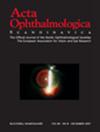Association of lipid-lowering agent use and dry eye disease: A nationwide matched case–control study in Taiwan, 2002–2016
Abstract
Purpose
The purpose of this study is to evaluate the association between lipid-lowering agent use and the risks of diagnosed dry eye disease (DED).
Methods
This retrospective, case–control study included 780 786 patients who received lipid-lowering agents in 2002–2016, of which 17 409 were newly diagnosed with DED during a ≥2-year follow-up period. These patients were matched 1:4 with control participants for age, sex, and comorbidities. Separate odds ratios (OR) were calculated for DED and each of statin and fibrate use.
Results
Statin users had significantly higher odds of DED (adjusted OR = 1.12; 95% confidence interval (CI) = 1.08–1.16, p < 0.0001) than nonusers. Fibrate users did not show higher odds of DED than nonusers (adjusted OR = 1.04; 95% CI = 0.99–1.10, p = 0.125). The lipophilic statin users did not show higher odds of DED compared with the hydrophilic statin users (adjusted OR = 0.99, 95% CI = 0.93–1.06, p = 0.729). Among statin users, the odds of DED did not differ significantly between patients receiving statin therapy for >180 days vs. ≤90 days or patients receiving statin therapy for 91–180 days vs. ≤90 days (adjusted OR = 1.00, p = 0.922; adjusted OR = 0.94, p = 0.541, respectively). The odds of DED were not statistically different among patients receiving low-intensity, moderate-intensity, and high-intensity of statin therapy.
Conclusions
Patients receiving statin therapy had a higher DED risk than patients not receiving statin therapy. The type of statin, the duration, and the intensity of statin use were not significantly associated with DED risks. Further studies are required to identify the relevant factors related to DED risks with statin.

 求助内容:
求助内容: 应助结果提醒方式:
应助结果提醒方式:


